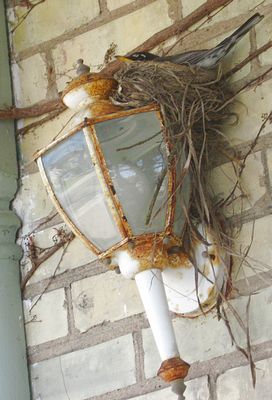
Martha got very upset at us when we attached the monster trellis to the front porch. We're planning on growing hops all over the trellis and porch.
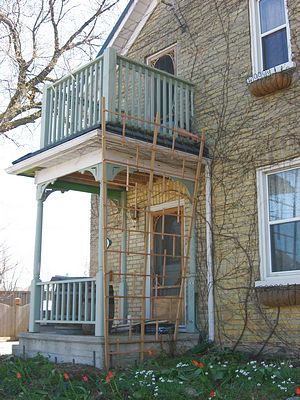
Later in the weekend, we went here....
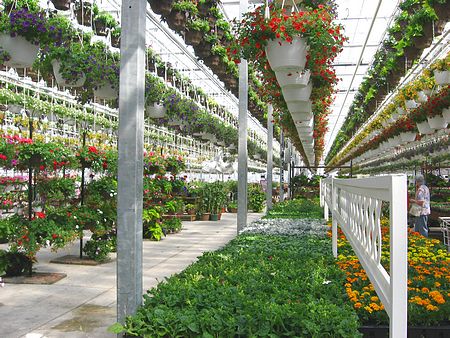
....and managed to escape with only a few dozen more plants. :)
The front garden is alive with light and colour these days.
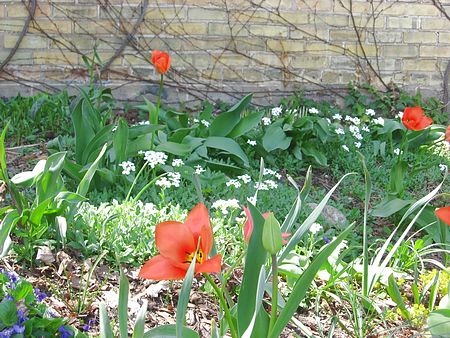
An anemone, close up.

The first tulip of the spring.
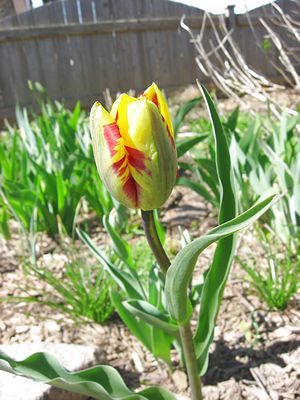
And yes, I do some fiber things.... here's the madder plants I hope to dye with this fall. Finally, I think, they'll be old enough. Madder roots need to be at least 3 years old to dye with.
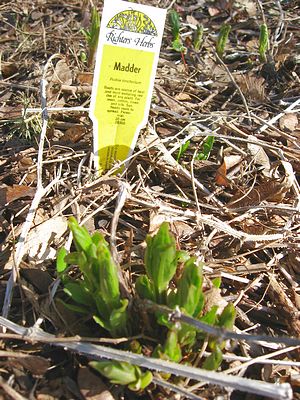
Leif the Licky wasn't terribly happy at being on the other side of the gate for most of our working out in the front of the yard.
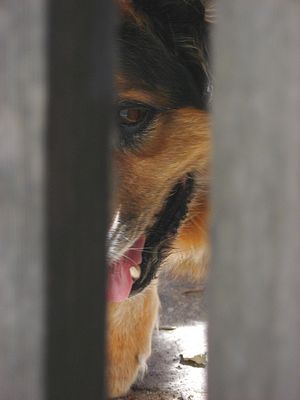
I've just finished reading a new book - The 100 Mile Diet: a year of eating locally, by Alisha Smith and James McKinnon.
It's quite thought-provoking. Did you know the average foodstuff travels 1,500 miles before reaching our local grocery store?
Did you know that it bugs me that the authors are Canadian and defined their local food circle in miles, and not kilometres? But I suppose that's just a petty digression...
Anyway, I've been thinking about this Eat Local thing ever since Liz ran the One Local Summer challenge at Pocket Farm last summer. Last year was a non-starter for me, but I might join in this year. It takes me awhile to get from growing awareness to doing. There's just so many questions to ask yet, and answer.
Let me give an example: there's a local butcher in town. But where does he get his meat? Where do the cows come from? What about the food that the cows ate while growing up?
Just how local is local?
The authors of "The 100 Mile Diet" took their definition right down to the ingredients. They didn't have any wheat products in their diet for eight months until they found a farmer growing wheat in their 100 mile circle.
I might be happy with locally made bread, even if the baker got his ingredients outside of the zone.
Food for thought indeed....
Karen
7 comments:
I love your trellis. Having hops grow up it is a fabulous idea! I think poor disgruntled Martha will like it better once it is all green and leafy.
Local butcher/baker - it's a start even if their ingredients come from far away. At least you're supporting the local economy!
It is worth asking about where the meat comes from, though. To raise the butcher's awareness that his customers care about such things and to ensure that you can feel good about the source of your food.
Anything that you can do is much better than what most people do! I started my path to change one choice at a time.
Karen, you asked, "Just how local is local?"
I think we each need to answer that for ourselves. I like to define "local" in stages: first Maine, then New England, then the Northeast, then the US, then from away. It may not be perfect, but no system is, really. :)
I can't often get Maine wheat, but I *can* get Maine-milled wheat, so I buy that. It supports a local (in this case, in my town) business, and the flour is fresher because it hasn't been sitting around, ground, in some warehouse for ages.
As for not knowing if the butcher has local meat, you need to ask. If the cows (just say) are raised locally on pasture (the best kind of meat, btw), you're pretty much guaranteed that they're eating local feed... just because it doesn't make economic sense to truck hay across the nation. Feedlot cattle are a different story, of course, because they're being raised on grain (totally unnatural!).
I hope you'll do OLS this year. A once a week local meal is a great way to dip your toes into the idea of eating locally. And it's fun! And there may even be prizes! :)
Love the photo of your robin Martha! We once had a robin build a nest in a similiar location...couldn't turn that light on for weeks!
Your spring bloomers are lovely!
(guess that snow was good for somethin!)
You know, Canada only went to using metric because the US was going to do it-and then backed out. So using miles may, in fact, be more Canadian than using kilometers.
Your home is adorable!...I can imagine the trellis being covered with vines...what color does madder produce when used as a dye?
Hi Sherri, Hi all!
Madder roots give various shades of red when used as a dye.
The redcoats of the British in American history? That's madder root.
Karen
Post a Comment